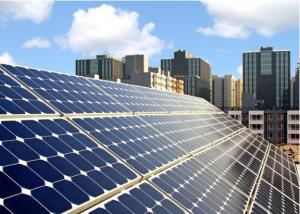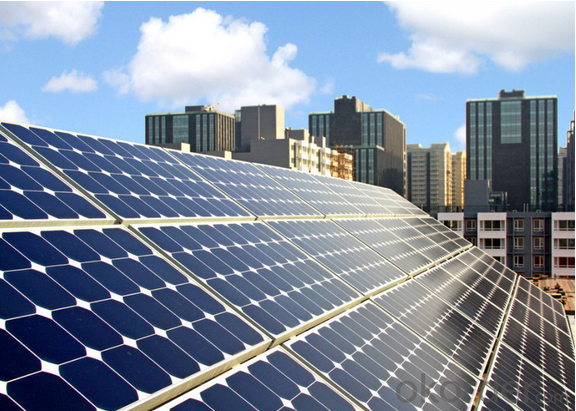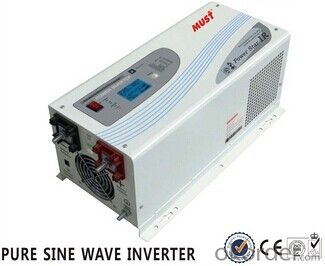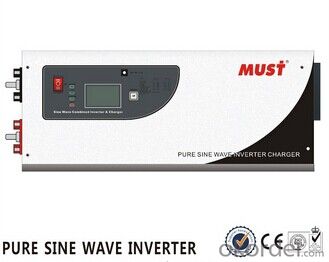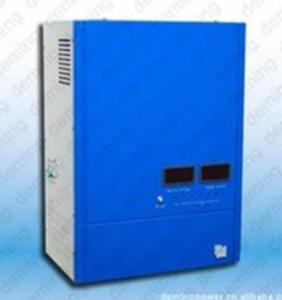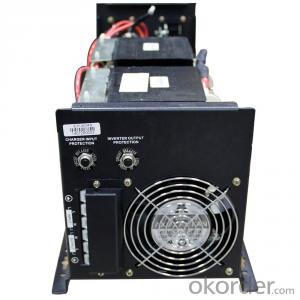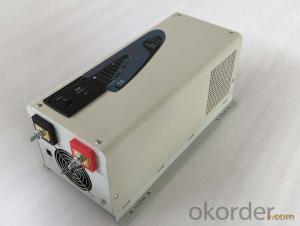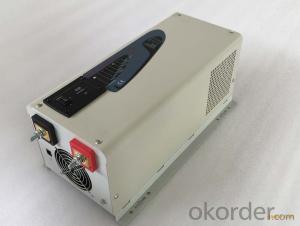Best Rv Solar Controllers - Pure Sine Wave Power Solar Inverter 1000W
- Loading Port:
- Shekou
- Payment Terms:
- TT or LC
- Min Order Qty:
- 100 pc
- Supply Capability:
- 100000 pc/month
OKorder Service Pledge
OKorder Financial Service
You Might Also Like
Product Description
Solar 1000w 1500w 2000w 3000w Pure Sine Wave Inverter 12V 24V 48V to 230V
1.Pure Sine Wave Inverter Features:
1. 1kw-6kw power range,12v / 24v / 48vdc optional,use copper transformer to increase efficiency;
2.165v-260v wide input voltage range ,40-70HZ input frequency;
3.low frequency and pure sine wave which can run inductive loads . main use for home and office: computer, lights, fan,tv, fridge,air-condition .etc;
4. built in 4 steps supper battery charger 30-75A to save charge time.Charger (bulk, absorption, float);
5. with 200cm battery cable;
6. Support generator 1hp/2hp/3hp;
7. Support solar system;
8. Remote control / RS232 , monitor inverter working by computer;
9. CE/ SONCAP certificate;
10. Charge current is adjustable 25%,50%,75%.100%;
11.Hybird solar system , Solar advantage, battery advantage;
NEW FUNCTION :(Solar Priority/Battery Priority Function)
SOLAR HYBIRD INVERTER : Solar Energy , City power , DC to AC can transfer automatically
When battery voltage is low (3 options---10v/10.5v/11v) , it will turn to city power automatically
220V/230V dc/ac pure sine wave best ups solar power inverter generator 1000W 1500W 2000w 3000w 4000w 5000w 6000w solar inverter
2. Pure Sine Wave Inverter Specification
| Model | EP3000 Series | 1000 | 2000 | 3000 | 3000 | 4000 | 5000 | 6000 |
| Capacity | W | 1000W | 2000W | 3000W | 3000W | 4000W | 5000W | 6000W |
| Battery | DC Voltage (Optional) | 12V | 24V or 12 | 24V | 48V | 48V | 48V | 48V |
| Recharge current | 35+/-5A | 35+/-5A | 45+/-5A | 35+/-5A | 35+/-5A | 40+/-5A | 50+/-5A | |
| 3 - stage charge | Boost CC → Boost CV → Float | |||||||
| Input | Nominal Voltage | 120VAC or 230VAC | ||||||
| voltage trip range | 90v+-4% to 140v+-4% or 184v/154v +-4% to 253v+-4% | |||||||
| Voltage re engage range | 100v+-4% -135v+-4% or 194v/164v+-4% to 243v+-4% | |||||||
| Max input AC voltage | 150VAC or 270VAC | |||||||
| Frequency | 50Hz or 60Hz(Auto detect) | |||||||
| Current | 25 Amps in maximum | |||||||
| Efficiency | 95% | |||||||
| Output | Voltage | 120V or 230V AC ±5% | ||||||
| Wave form | Pure Sine wave | |||||||
| Frequency | 50/60Hz | |||||||
| voltage range | Depends on battery type | |||||||
| Transfer time | ≤5ms | |||||||
| Protection | Overload | 15 mins for 125%, 60s for 150%, 20s for over 150s | ||||||
| Short circuit protection | Fault after 10 secs | |||||||
| Electric Fans | Thermo -controlling | |||||||
| Static Consumption | < 10 Watts | |||||||
| Surroundings | Temperature, humidity | 0-50 °C ,90%, no condensing | ||||||
| Surge rating (10s) | 3000W | 6000W | 9000W | 9000W | 8000W | 10000W | 12000W | |
| capable of starting electric moto | 1HP | 2HP | 3HP | 3HP | 4HP | 5HP | 6HP | |
| Physical | Mount | Horizontal wall mount | ||||||
| Size CM (H x W x D) | 44.2 x 21.8 x 17.9 | 63.0 x 21.8 x 17.9 | ||||||
| Carton CM (H x W x D) | 58.0x32.0x31.0 | 75.5 x32.0x31.0 | ||||||
| N.W ( KGS) | 19 | 21 | 25 | 25 | 35 | 38 | 40 | |
| G.W (KGS) | 21 | 23 | 27 | 27 | 37 | 40 | 42 | |
| Remark | Specification for reference , subject to change without prior notification | |||||||
| We accept order with special specifications | ||||||||
3. Pure Sine Wave Power inverter Packing:
Power inverter 1000W 2000W 3000W 4000W 5000W 6000W Inverters

4. EP3000 Pure Sine Wave Solar Power Inverter on the Solar System:

- Q: Can a solar controller be used with different types of solar panel cleaning systems?
- Yes, a solar controller can be used with different types of solar panel cleaning systems as long as they are compatible with the controller's specifications and requirements. The controller's main function is to regulate and optimize the charging process of the solar panel system, regardless of the cleaning method being used.
- Q: How does a solar controller handle low voltage disconnect for battery protection?
- A solar controller handles low voltage disconnect for battery protection by constantly monitoring the battery voltage. When the voltage drops to a predetermined threshold, typically around 11.5 volts, the controller automatically disconnects the load from the battery. This prevents the battery from being over-discharged, which can lead to permanent damage and reduced lifespan. Once the battery voltage rises above a certain level, usually around 12.6 volts, the controller re-connects the load, ensuring that the battery remains protected and operational.
- Q: How does a solar controller prevent damage to the solar panels?
- A solar controller prevents damage to solar panels by regulating the flow of electricity from the solar panels to the batteries or power grid. It ensures that the panels do not overcharge the batteries, which can cause damage due to excessive voltage. Additionally, a solar controller can also prevent the batteries from discharging too much, which can lead to damage or reduced lifespan of the panels.
- Q: Can a solar controller be used with a remote monitoring system?
- Yes, a solar controller can be used with a remote monitoring system. A solar controller, also known as a charge controller, is an essential component of a solar power system. It regulates the flow of electricity from the solar panels to the battery bank, ensuring that the batteries are charged efficiently and preventing overcharging or damage to the batteries. A remote monitoring system allows users to monitor and control their solar power system from a distance, typically through a computer or mobile device. It provides real-time data on the performance of the solar panels, battery charge levels, and other important parameters. By integrating a solar controller with a remote monitoring system, users can easily and conveniently monitor the status and performance of their solar power system from anywhere. They can keep track of the battery charge levels, adjust charging settings, and receive alerts or notifications in case of any issues or abnormalities. This combination of a solar controller and a remote monitoring system not only enhances the overall efficiency and performance of the solar power system but also provides users with greater control and peace of mind. It allows for better management and optimization of the solar power system, ensuring maximum energy production and utilization.
- Q: Can a solar controller be used with a solar-powered battery charger?
- Indeed, a solar-powered battery charger can be paired with a solar controller. Referred to as a charge controller, the solar controller operates to regulate the battery's charging procedure by harnessing solar panels. Its purpose is to safeguard the battery against potential harm caused by excessive charging or discharging, thereby prolonging its lifespan. When combined with a solar-powered battery charger, the solar controller guarantees that the battery is charged in an effective and secure manner, thereby optimizing both its performance and durability.
- Q: How does temperature affect the charging process in a solar controller?
- Temperature can have a significant impact on the charging process in a solar controller. Solar controllers are responsible for regulating the charging of batteries in a solar power system. When the temperature increases, it can lead to certain changes in the charging process. One important consideration is the battery's capacity. Higher temperatures can cause the battery's capacity to decrease, meaning it can hold less charge. This can affect the overall charging process as the solar controller needs to adjust its charging algorithm to ensure optimal charging without overcharging the battery. Another aspect affected by temperature is the charging voltage. As temperature increases, the charging voltage needs to be adjusted to compensate for the battery's reduced capacity. This adjustment ensures that the battery receives the appropriate voltage to be charged effectively. Furthermore, temperature can impact the battery's internal resistance. Higher temperatures typically result in lower internal resistance, which can cause the battery to charge more rapidly. However, it is crucial to have a solar controller that can monitor and regulate the charging process to prevent overcharging, as excessive heat can also damage the battery. In colder temperatures, the charging process can be affected as well. When the temperature drops, the battery's capacity tends to increase. This means it can hold more charge, and the solar controller needs to adjust its charging algorithm accordingly to avoid undercharging the battery. In summary, temperature plays a crucial role in the charging process of a solar controller. It affects the battery's capacity, charging voltage, and internal resistance. A well-designed solar controller will monitor and adjust these parameters to ensure efficient and safe charging, regardless of the temperature conditions.
- Q: What is the maximum temperature range a solar controller can operate in?
- The maximum temperature range a solar controller can operate in typically ranges from -40°C to 85°C (-40°F to 185°F).
- Q: Can a solar controller be used with solar panels that are connected to a battery isolator?
- Yes, a solar controller can be used with solar panels that are connected to a battery isolator. A solar controller is designed to regulate the charging of batteries from solar panels, ensuring that they are charged efficiently and safely. When solar panels are connected to a battery isolator, the solar controller can still effectively manage the charging process by controlling the flow of solar power to the batteries. The battery isolator acts as a device that allows power to flow from the solar panels to the batteries while preventing power from flowing back to the solar panels. This setup is commonly used in off-grid solar systems or in situations where multiple battery banks need to be charged simultaneously. By using a solar controller in conjunction with a battery isolator, the solar panels can effectively charge the batteries while protecting them from overcharging or damage.
- Q: How does a PWM solar controller differ from an MPPT solar controller?
- Solar power systems utilize both PWM (Pulse Width Modulation) and MPPT (Maximum Power Point Tracking) solar controllers to regulate battery charging from PV panels. However, their functionality and efficiency differ significantly. A PWM solar controller is a commonly used and basic type of solar charge controller. It controls charging by rapidly switching the PV panel's output voltage between the battery and panel voltages. This creates a pulsating charging current that gradually decreases as the battery reaches full capacity. PWM controllers are simpler and less expensive compared to MPPT controllers. In contrast, an MPPT solar controller is a more advanced and efficient type of solar charge controller. Its main function is to maximize power output from PV panels by tracking the maximum power point of the panel's voltage-current curve. By continuously adjusting the PV panel's output voltage to match the battery's optimal charging voltage, an MPPT controller ensures maximum power extraction, resulting in higher charging efficiency. MPPT controllers are particularly useful when the PV panel's voltage is much higher than the battery's voltage, as they can step down the voltage without wasting excess energy as heat. To summarize, the main difference between PWM and MPPT solar controllers lies in their charging mechanisms and efficiency. While PWM controllers use a basic switching method, MPPT controllers utilize sophisticated electronics to track and extract maximum power from PV panels. As a result, MPPT controllers are generally more expensive but offer higher charging efficiency and better utilization of available solar power.
- Q: What is the maximum charging capacity a solar controller can handle?
- The maximum charging capacity a solar controller can handle depends on its specifications and capabilities. It can range from a few amps to several hundred amps, depending on the size and type of the solar controller.
Send your message to us
Best Rv Solar Controllers - Pure Sine Wave Power Solar Inverter 1000W
- Loading Port:
- Shekou
- Payment Terms:
- TT or LC
- Min Order Qty:
- 100 pc
- Supply Capability:
- 100000 pc/month
OKorder Service Pledge
OKorder Financial Service
Similar products
Hot products
Hot Searches
Related keywords
